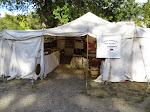When I started reenacting I was under the impression that the Victorians were so utilitarian that they only had buttons made from bone, shell, wood or other readily available, but primitive material. The fact is that the Victorians were very fancy. If you look at pictures from the era, you will often see buttons of a contrasting color gracing the front of a lady’s blouse or dress. Their buttons were their adornment. Buttons of the day were made of china, rubber, gutta percha, horn, metal, ivory and any other media available. While I am not an expert, I will be starting a series here on Victorian buttons, and one of the most prized and sought-after buttons is the calico.
Calico buttons are a type of china button, named after the fabric which it was created to compliment. You can tell the difference between a china button and a plastic button by looking at the back. A china button is rough where it sat in the kiln. A plastic button is smooth, and may have a small dot where the plastic was injected into the mold. China buttons also feel cooler to the touch, if you hold them to your cheek, than plastic.
Calicos got their start in 1840 when Richard Prosser patented a method of compressing a fine dry powder into a button, which was then fired. The design is then affixed using transfer paper and then baked again.1 A whole cache of calico buttons were found on the wreck of the Steamship Arabia which sank in 1856 in Kansas. This places them well before the Civil War.
Buttons originally came on a card. The purchaser would specify how many buttons they wanted, and the sales clerk would cut off the amount that was needed. Many of the carded china buttons that I have seen indicate that they were made in France, in the Bapterosses plant.
These buttons come in many different shapes, sizes and colors, and are available in two, three, and four hole. Some even come rimmed with metal (these are rare and bring a good price on the market.) Three hundred twenty six different patterns have been identified. The most common calico is a colored pattern on white; however, there is also a white on dark variation. Because of the difficulty of finding complete sets of these buttons, reproductions are a reasonable alternative for living historians. These are available at http://www.annaandabigails.com/.
1 Lamm, Ruth, Beatrice and Lester Lorah, and Helen W. Schuler. Guidelines for Collecting
China Buttons. Boyertown, PA. 1970.


No comments:
Post a Comment
Would love to hear your comments.